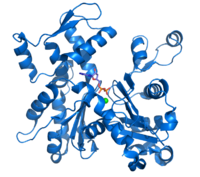
Photo from wikipedia
Alphaviruses are human pathogens that cause both debilitating acute and chronic musculoskeletal disease and potentially fatal encephalitis. In this study, we determined that two highly conserved phenylalanine residues in the… Click to show full abstract
Alphaviruses are human pathogens that cause both debilitating acute and chronic musculoskeletal disease and potentially fatal encephalitis. In this study, we determined that two highly conserved phenylalanine residues in the alphavirus E1 glycoprotein are required for fusion of viral and host cell membranes and viral entry into target cells. ABSTRACT Alphaviruses infect cells by a low pH-dependent fusion reaction between viral and host cell membranes that is mediated by the viral E1 glycoprotein. Most reported alphavirus E1 sequences include two phenylalanines (F87 and F95) in the fusion loop, yet the role of these residues in viral infectivity remains to be defined. Following introduction of wild type (WT), E1-F87A, and E1-F95A chikungunya virus (CHIKV) RNA genomes into cells, viral particle production was similar in magnitude. However, CHIKV E1-F87A and E1-F95A virions displayed impaired infectivity compared with WT CHIKV particles. Although WT, E1-F87A, and E1-F95A particles bound cells with similar efficiencies, E1-F87A and E1-F95A particles were unable to undergo fusion and entry into cells. Introduction of an F95A mutation in the E1 fusion loop of Mayaro virus or Venezuelan equine encephalitis virus also resulted in poorly infectious virions. We further tested whether an E1-F87A or E1-F95A mutation could be incorporated into a live-attenuated vaccine strain, CHIKV 181/25, to enhance vaccine safety. Infection of immunocompromised Ifnar1−/− and Irf3−/−Irf5−/−Irf7−/− mice with 181/25E1-F87A or 181/25E1-F95A resulted in 0% mortality, compared with 100% mortality following 181/25 infection. Despite this enhanced attenuation, surviving Ifnar1−/− and Irf3−/−Irf5−/−Irf7−/− mice were protected against virulent virus re-challenge. Moreover, single-dose immunization of WT mice with either 181/25, 181/25E1-F87A, or 181/25E1-F95A elicited CHIKV-specific antibody responses and protected against pathogenic CHIKV challenge. These studies define a critical function for residues E1-F87 and E1-F95 in alphavirus fusion and entry into target cells and suggest that incorporation of these mutations could enhance the safety of live-attenuated alphavirus vaccine candidates. IMPORTANCE Alphaviruses are human pathogens that cause both debilitating acute and chronic musculoskeletal disease and potentially fatal encephalitis. In this study, we determined that two highly conserved phenylalanine residues in the alphavirus E1 glycoprotein are required for fusion of viral and host cell membranes and viral entry into target cells. We further demonstrated that mutation of these phenylalanines results in a substantial loss of viral virulence but not immunogenicity. These data enhance an understanding of the viral determinants of alphavirus entry into host cells and could contribute to the development of new antivirals targeting these conserved phenylalanines or new live-attenuated alphavirus vaccines.
Journal Title: Journal of Virology
Year Published: 2022
Link to full text (if available)
Share on Social Media: Sign Up to like & get
recommendations!